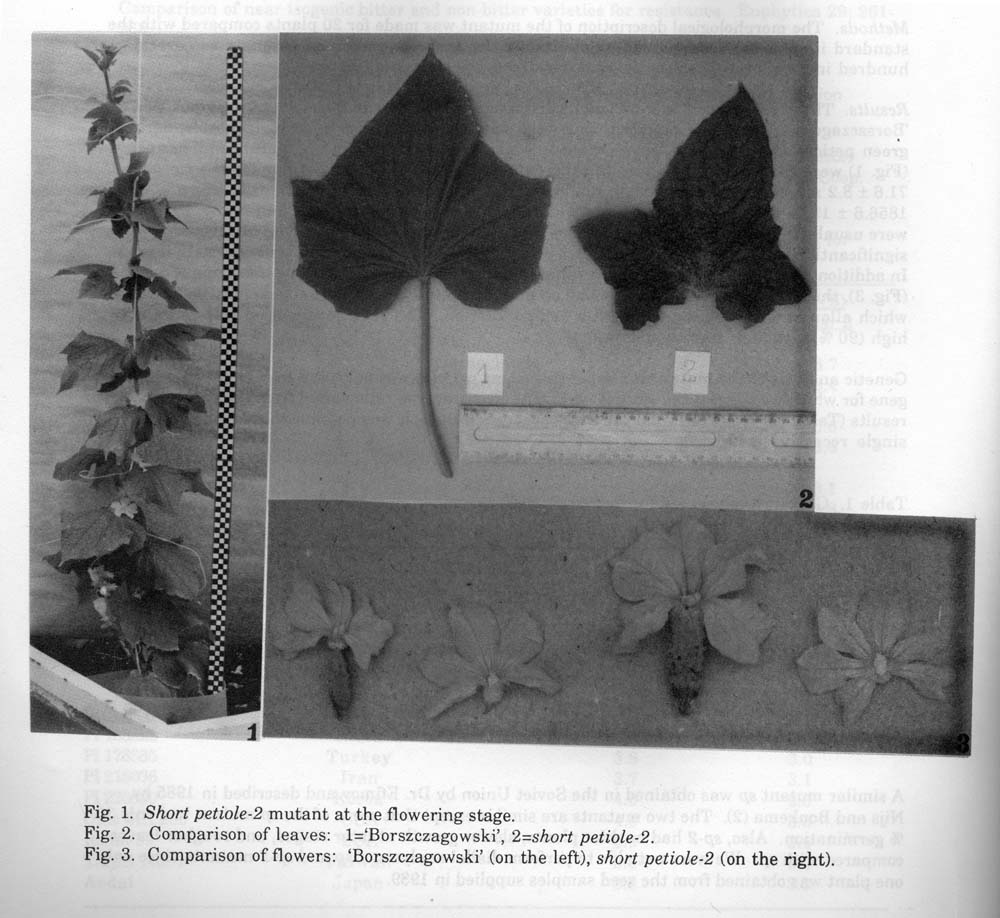Cucurbit Genetics Cooperative Report 15:33-34 (article 12) 1992
M. Rucinska, K. Niemirowicz-Szcytt and A. Korzeniewska
Department of Genetics and Horticultural Plant Breeding, Warsaw Agricultural University – SGGW, 02-766 Warsaw, Poland
The Short petiole-2 mutation of cucumber is part of our collection of chemically-induced mutants obtained by Kubicki (1). The first mutant line from the collection was reported last year (3), and we are going to continue this series of descriptions not published before.
Methods. The morphological description of the mutant was made for 20 plants compared with the standard inbred, ‘Borszczagowski’, while its genetic analysis concerned as many as several hundred individuals. The results were verified using statistical methods.
Results. The short petiole-2 mutant can be distinguished at the 2- to 3-leaf stage. Compared with ‘Borszczagowski’, plant of short petiole-2 were smaller, with shorter hypocotyl, shorter, darker green petioles, and crinkled leaves showing some developmental delay. Mature individuals (Fig. 1) were characterized by a significantly shorter hypocotyl (45.0 + 8.4 mm for short petiole-2, 71.6 + 8.2 mm for ‘Borszczagowski’), smaller size of plant (1203.7 + 74.8 mm for short petiole-2, 1856.6 + 121.7 for ‘Borszczagowski). There was almost no branching and if any, branches were usually very short, while the standard had 20 branches on average. Leaf petioles were significantly shorter (5 to 70 mm for short petiole-2, 120 to 210 mm for ‘Borszczagowski’) (Fig. 2). In addition, flowers of the tested plants differed from those of the standard by the shape of ovary (Fig. 3). thicker petals and lack of netting on mature fruits. The mutant appeared to be fertile, which allowed for obtaining seeds after self-pollination. The seed germination was relatively high (90%) although slightly delayed.
Genetic analysis of the mutant indicated that short petioles were governed by a single recessive gene for which we suggest the symbol, sp-2. The F2 phenotype ratio varied from the expected results (Table 1). However, from the first backcross to sp-2, it was possible to confirm control by a single recessive gene.
Table 1. Genetic analysis of short petiole-2 (sp-2) cucumber mutant in a cross with ‘Borszczagowski’ (B).
No. obtained |
No. expected |
Tested ratio |
|||||
Generation |
Normal |
Mutant |
Normal |
Mutant |
X² |
P |
|
| P1(B) | 39 | — | 39 | — | 1:0 | — | — |
| P2 (sp-2) | — | 84 | — | 84 | 0:1 | — | — |
| F1 | 99 | — | 99 | — | 1:0 | — | — |
| F2 | 333 | 93 | 319.5 | 106.5 | 3:1 | 0.804 | 0.05 |
| BC1P1 | 160 | — | 160 | — | 1:0 | — | — |
| BC1P2 | 90 | 88 | 89 | 89 | 1:1 | 0.022 | 0.05 |
A similar mutant sp was obtained in the Society Union by Dr. Efimov and described in 1985 by Nijs and Boukema (2). The two mutants are similar except that seeds of the sp mutant had only 30% germination. Also, sp-2 had bushier plants, slower growth at later stages, and rougher leaves compared with sp. We were not able to perform diallel analysis of sp and sp-2 mutants since only one plant was obtained from the seed samples supplied in 1989.
Figure 1. Short petiole-2 mutant at the flowering stage.
Figure 2. Comparison of leaves: 1 = ‘Borszczagowski’, 2 = short petiole-2.
Figure 3. Comparison of flowers: ‘Borszczagowski’ (on the left), short petiole-2 (on the right).

Literature Cited
- Kubicki, B. 1983. Included mutation in cucumber (Cucumis sativus L.). I. Variability in m1 and m2 generation. Gen. Pol. 21(4): 409-424.
- Nijs A.P.M. den and I.W. Boukema. 1985. Short petiole, a useful seedling marker for genetic studies in cucumber. Cucurbit Genet. Coop. Rpt. 8:7.
- Ruciinska, M. K. Niemirowicz-Szczytt and A. Korzeniewska. 1991. A cucumber (Cucumis sativus L.) mutant with yellow stem and leaf petioles. Cucurbit Genet. Coop. Rpt. 14: 8-9.